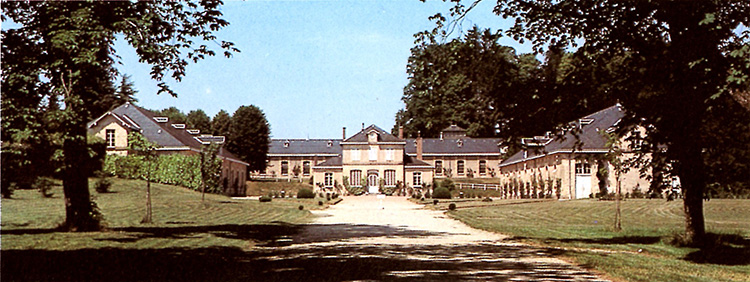 Christopher Hector looks at a breed under threat
Christopher Hector looks at a breed under threat
It is something of a tragedy, that right at the time eventing riders are discovering that a good dollop of French Anglo blood is just the thing to produce an international eventer – the breed is in danger of disappearing!
Stars of recent years out of Anglo dams include the German stars Sandra Auffarth’s Opgun Louvo and Michael Jung’s frontliner, fischerTakinou.
British bred, Frenchman, Thomas Carlile has made his name with eventers out of Anglo mares. He won the Seven-year-old World Young Horse Eventing Champs in 2013 with Sirocco du Gers, by the Selle Français stallion, Dorsay, but out of an Anglo mare by Jalienny. Thomas rode Sirocco at the European Championships in 2014.
He won the Six-year-old champion in 2013 with Tenareze by Jaguar Mail out of an Anglo mare by Quatar de Plape, and then came back with the horse the next year to win the seven-year-old class. Thomas was ranked 12th on the last World Eventing Rankings with Upsilon, out of an Anglo mare, but by the Holsteiner, Canturo. Thomas had a sensational 2016 with Upsilon, winning two two-stars, Hartpury and Jardy, placing 3rd at Saumur ***, 2nd at Gatcombe and winning Blenheim***.
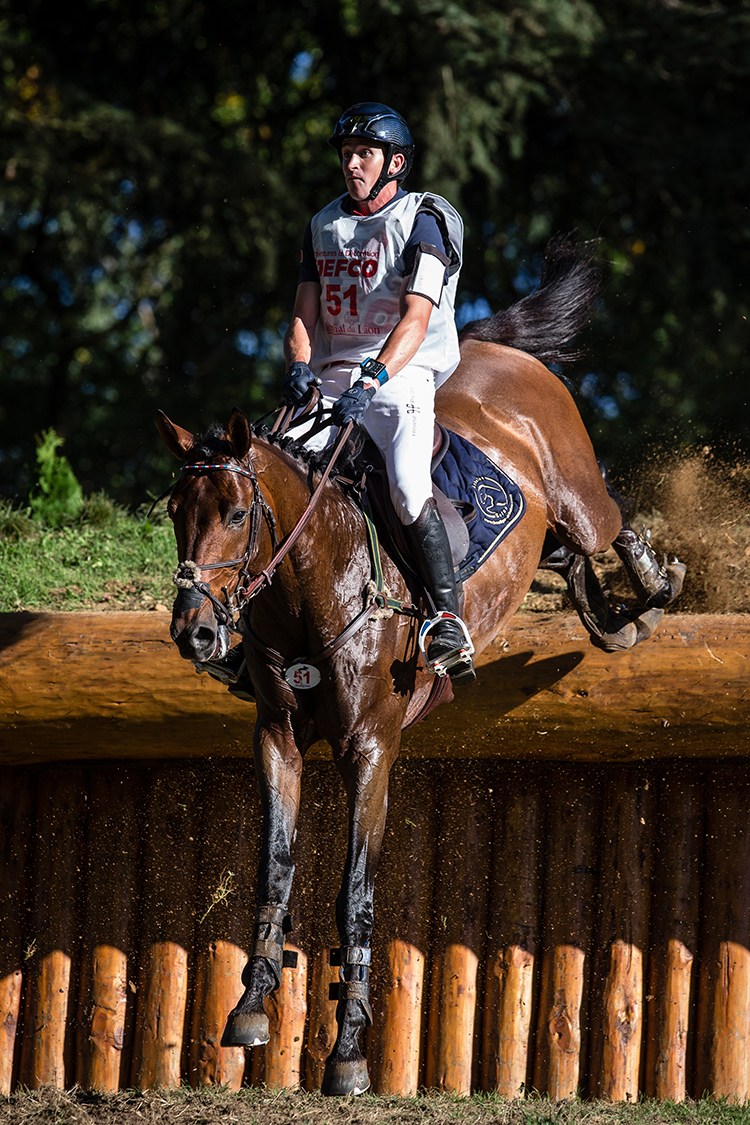
Thomas Carlile with World Champion Tenareze / Photo: Eric Knoll
fischerTakinou was bred by one of the younger breeders, Mathieu Boisselier: “My wife and I, we began breeding in the year 2000 – breeding only for eventing. I am an eventing rider, I am also very tall, so it’s hard to find horses for me, so I have to breed them. I bought the mother of Takinou from another rider, Gilles Pons, and then we bred Takinou. It is a family thing, Gilles lives near me, and he is also my coach.”
The mare, Gita aa is by Sardana Pierre aa out of Paladine aa by Roslem II aa. She has three crosses of the chef de race Nithard.
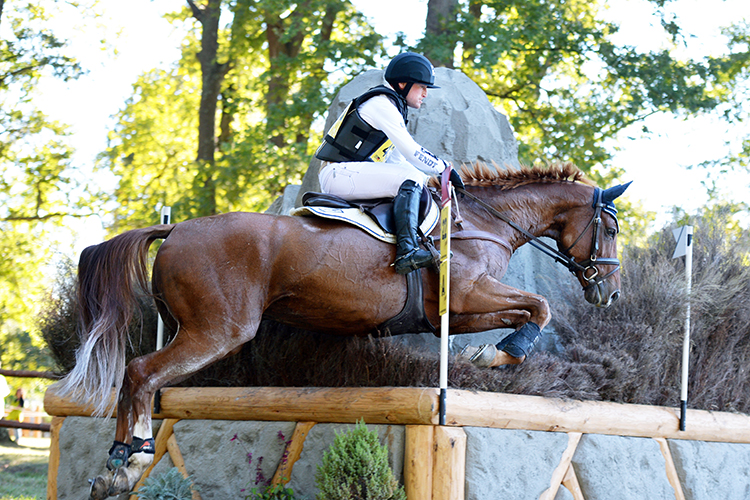
fischerTakinou – the magic cross Selle Français over Anglo-Arab
“Now I have a full sister of Takinou, so this family continues for me.”
Why did you choose Jaguar Mail to breed Gita to?
“I fell in love with him. He was about five or six when I sent her to him the first time. For me, Jaguar Mail should be an eventing horse, not a showjumping horse. Yes, he made the Olympics as a showjumper, but if you put Jaguar Mail in Eventing, I am sure he would be four-star. He is wonderful.”
Most breeders are trying to breed showjumpers…
“Yes, and the horses that don’t jump well enough, they go to eventing, but we decided 15 years ago, to only breed for eventing. Now there are some people breeding for eventing, but when we started we were one of the first. We prefer quality to quantity, so we only have three or four foals a year. Now we have two sisters of Takinou, we have one sister of Appy d’Hulm who will be in the six year old championships at Lion d’Angers. He is black and white with blue eyes. I bought a mare with two colours because I wanted to send a horse with two colours to Lion d’Angers. So I spent four years looking for the perfect mare, I didn’t just want the colour, I wanted a good mare.”
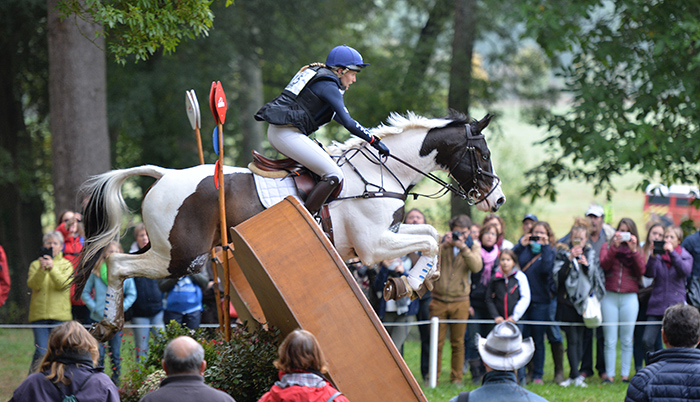
Appy d’Hulm, by Visage, the stallion who spent a large part of his breeding life in Australia
And yes, when we saw Appy we thought he looked familiar, he is by Visage who grew up and World Cup showjumped in Australia before competing in Europe, and then returning to Australia…
What stallions are you using?
“We try to use young stallions. For example, Upsilon of Tom Carlile, we have bred the full sister of Takinou to him. Upsilon won three-star at the age of eight, and Takinou was European champion at eight, so perhaps at eight that foal will be wonderful.”
How did Takinou end up with Michael Jung?
“When Takinou was born, my son was four and he didn’t like horses, when he saw Takinou he said, this is the most beautiful horse I have ever seen, and I want him to have the same name as my teddy bear. I sold the horse at three at the sales at Lion d’Angers, he was the top price of the Anglo-Arabs. He was bought for Jennifer Vuillemin, a French rider. She rode him when he was four, five, six, and qualified for Lion d’Angers. On the Wednesday morning at Lion d’Angers, Joachim Jung, the father of Michael, saw the horse. He phoned the owner and said, is the horse for sale? The owner didn’t know who Joachim was, said yes, for sure. How much? He named the price. The next thing the owner knew, Michael Jung came to try the horse and he bought him.” (article continues below)
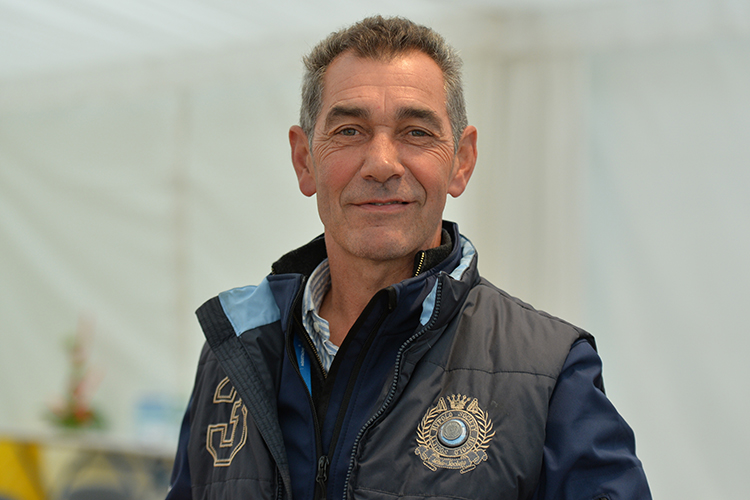
It seemed a good idea to talk with Gilles Pons who bred the mother of Takinou. Gilles has been a consistent performer on the French eventing scene. Gilles rode at the very first WEG in Stockholm, on Olympic.
Has your family always bred Anglo-Arabs?
“The Anglo-Arab has been in our family for five generations, it is a long history.”
Why did you concentrate on Anglo-Arabs?
“In this region, the basin of the River Adour, this was the very starting point of the Anglo-Arab base. As we live here, it is natural to stay with this breed and develop it, to give value to those horses, and stick to them.”
Has the Anglo-Arab changed like all the other breeds – from a heavier horse to a lighter more modern horse, or was the breed always like it is today?
“I regret that there have been a lot of changes, the original Anglo-Arabs don’t exist any more – so they decided to introduce cross breeding, with Holsteiners, with Trakehners, this foreign blood was supposed to bring in power and good movement because at the time the Anglo-Arabs had lost this a bit.”
“What didn’t help was that the French breeding system, through the Haras Nationaux (state studs) didn’t guard the Anglo-Arab breed, they let in foreign blood and it became more and more crossed. The Haras don’t exist any more, and there is not enough support to have a real Anglo-Arab breed. Nowadays, there are less and less pure Anglo-Arabs because there are no stallions any more, it’s a pity, but that is the way it is.”
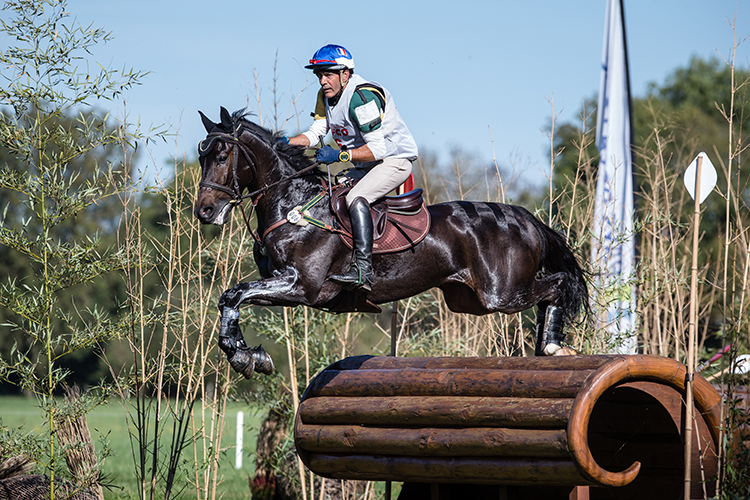
The new Anglo-Arab? Trakehner over Anglo-Arab. Gilles Pons and his home bred, Telstar de Bordenave by Grafenstolz out of a Fariland II mare / Photo: Eric Knoll
Many eventing riders like horses out of Anglo mares…
“That is true, and that is why we have kept Anglo mares in our family breeding, it’s very important because it brings good reflexes and blood, into the crossing.”
Why hasn’t there been a very important Anglo stallion since Nithard?
“There have been some other good stallions, not perhaps a chef de race like Nithard, but I really regret that the National Stud did not make a good enough selection of the Anglo-Arab stallions. They didn’t value and support the good stallions, so we lost them.”
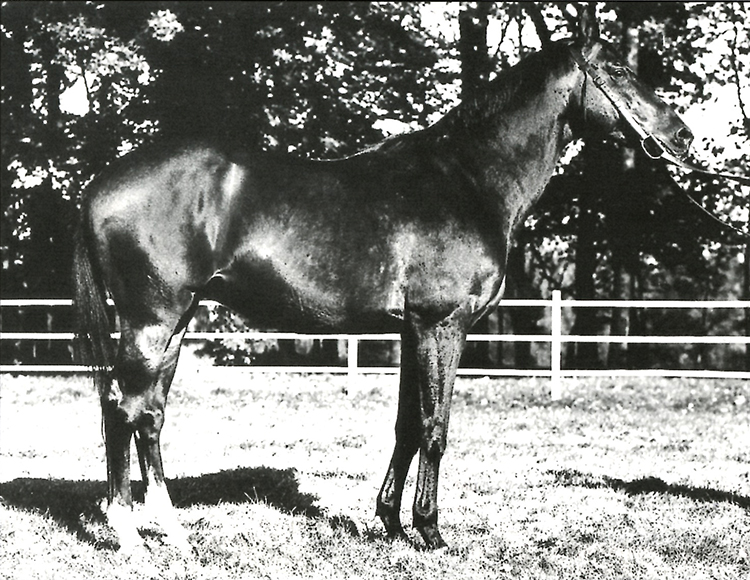
The famous Nithard, he crops up all the time on Anglo-Arab pedigrees
Is there a very good Anglo stallion in France today?
“Alas there is no pure Anglo-Arab stallion. Upsilon is a good stallion, but he is not pure Anglo-Arab. For many years in the state studs they wanted bigger horses, and the Anglo-Arab is about 1.65, and they wanted bigger and stronger horses, so they brought the other blood in, and so they lost the pure Anglo-Arab and they don’t have it any more. In my heart I am a pure Anglo-Arab breeder so it is very sad – and it makes it very important to keep our Anglo mares.”
Will there be a revival of the Anglo-Arab because of the new format of eventing?
“The foreign riders love the Anglo-Arab, they have never lost their image. but it is difficult to preserve the breed. I am using Upsilon, I bred the first Grafenstoltz in France, he is nine years old now, he is a good stallion. I have foals by Royaldik and Mighty Magic, those stallions will keep the shape, the model, of the Anglo-Arab, and save the breed.” (article continues below)
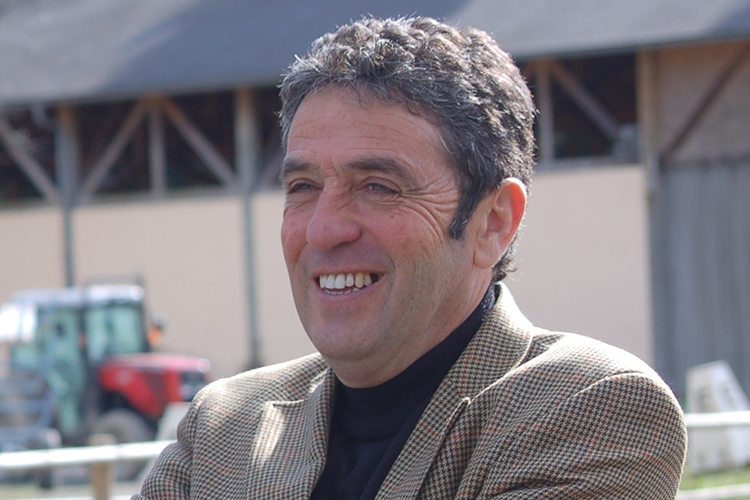
I also spoke with Alain James, an international judge, and a supporter of the Anglo-Arab breed. In fact, Alain is the president of the Anglo-Arab association:
“I have been the President since three months. I have been a technical delegate to the society for 20 years. In our association we have 400 breeders with 1,200 mares.”
I understand the problem is that there are no stallions left?
“There are some stallions, but it is a very small population with too much close blood. So we organized a few years ago, an international organization of the Anglo-Arabian breed with fourteen countries and I am president of this organization since yesterday. We can organize the selection in fourteen countries now. But we do have good stallions…”
Good Anglo stallions?
“Yes, for example, Upsilon.”
But he is not a pure Anglo-Arab…
“It’s an Anglo-Arab Section 3, a cross bred. The Section 3s are 30% of our population, because in this Section 3 we produce Anglo-Arabians adapted to the market.”
Do you think it was a pity that you lost the pure breed of Anglo-Arabs?
“No. We have a breeding program to help the pure race first, we help with money to produce pure race. One of the characteristics of the Anglo-Arabian breed is that we have races for the Anglo-Arabian, and the races are only for the pure Anglo-Arabian. Flat races and jumping races, and this permits us to keep the pure Anglo-Arabian, with the characteristic qualities of robustness, courage, and the quality of hard clean legs. Each year there are 200 Anglo-Arabians produced only for the races.”
“If a stallion is not pure Anglo-Arabian, then he has to be approved for our association by a committee of experts. We judge if the stallion is interesting, does he make good competition, and the type is right to produce Anglo Arabian.”
What outside stallions do you think will be a good influence on Anglo-Arabian breeding?
“There are a lot, all the stallions producing good international eventing competitors are interesting, and in jumping, the stallions with enough blood. There are many stallions crossing with our Anglo-Arabians now.”
The most popular?
“Canturo because he produced Upsilon. Jaguar Mail is a very good stallion in crossing especially for eventing.” (article continues below)
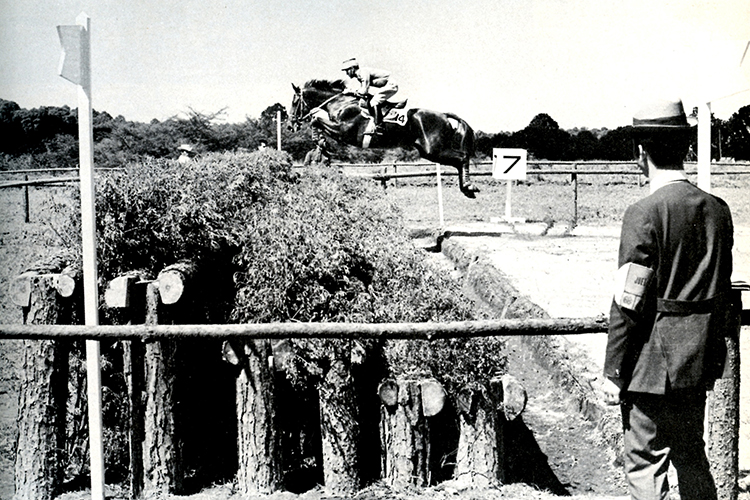
Pitou wins at the Mexico Olympics in 1964
Do you think Anglo-Arabians will become more popular for modern eventing?
“A lot of Anglo-Arabians have been very good in eventing for fifty years. Even back in 1948 at the London Games, the gold medal was won by Aiglonne. In Mexico, the winner was Pitou – for many years the Anglo-Arab has been produced for eventing. Now let’s have a horse adapted for the new eventing fashion, with paces – I think the new format is good for the Anglo-Arabian, more efforts with less distance. We need horses with good technique, good blood and a good mind. The Section 3, like Upsilon, or Takinou, are perfectly adapted for the new format. We see more and more foreign riders, like Michael Jung, coming to buy our horses. After the success in Rio, many people came to our National Championships in Pompadour to buy horses. It is strange – at Pompadour, they had their choice of 2, 3, 4, 5 and 6 year olds, and they bought mainly three year olds. On our web site we have a list of horses for sale as well.”
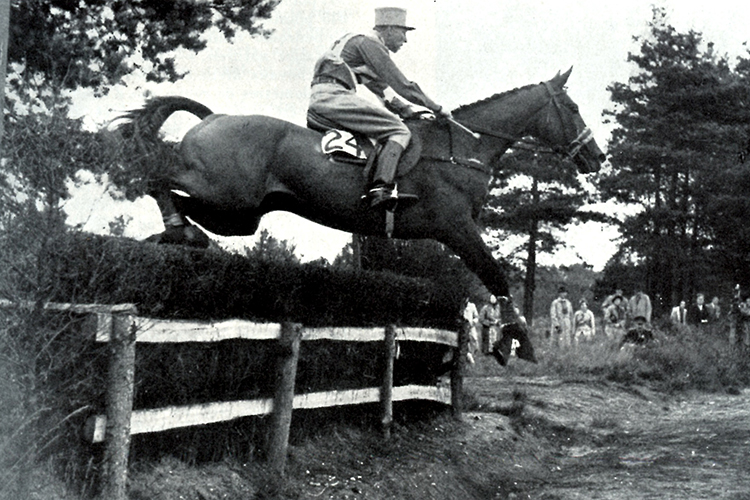
Aiglonne wins at the London Olympics in 1948
All around the world, sport horse breeding is down – did this affect the Anglo-Arabian?
“It’s a big problem for Anglo-Arabian breeders since it is a little population. Ten years ago, we had 2000 foals born annually, last year, there were less than 700, it’s not enough. The last two years it has been increasing, the only breed that is increasing, but it is not enough, this is why we have set up our international organization.”
What is the typical Anglo breeder?
“The little breeder, the average is 1.7 mares per breeder. The ones that are breeding for the races, then the average is 7 per breeder. The breeders for sport are amateurs…”
If the Anglo-Arab survives, I guess there should be a statue erected not to a horse, but to a young eventing rider who was born in France of British parents – Thomas Carlile, since he, more than any other person of recent times has put the Anglo-Arab squarely in the eyes of the world’s eventing fans.
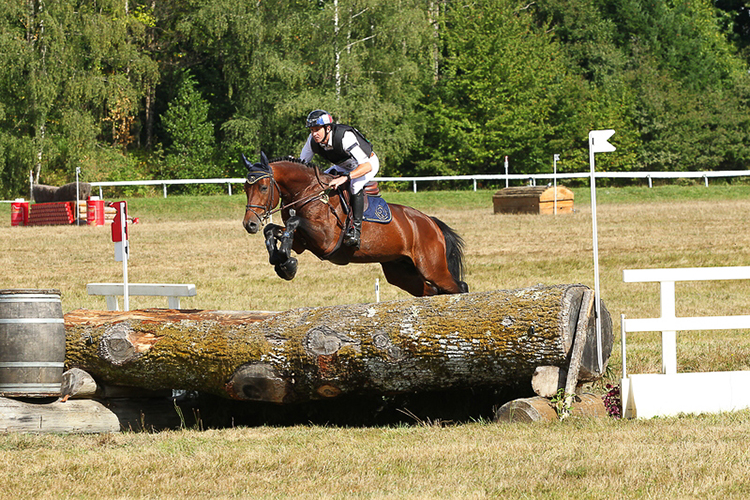
Cestuy la de l’Esques and Thomas Carlile – new blood for the breed
Is it an irony and a tragedy that right at the time the Anglo-Arab is proving itself such a great genetic base for breeding eventers, the breed is virtually extinct…
“Yes,” says Thomas. “It’s sad for the breeders themselves. It is a difficult situation because the Anglo-Arab Association doesn’t have that much money… a pure Anglo-Arab wouldn’t be Formula One for eventing but an Anglo cross is what everybody is looking for and to make Anglo cross you need pure!”
“I’m not so fussed about the breeding itself. I think what we riders are looking for is a type of horse, so whether we find the type and the qualities of an Anglo in an Anglo or in a Trakehner or in Thoroughbred, at the end of the day we’ve got good young stallions coming through, such as Upsilon, there was a Painter’s Maxim at Lion d’Angers, that looks fantastic. I think we’ve going to have an eventing breeding orientation, it’s a type we are looking for. It’s a bit sad for the Anglo-Arab breed but if the breed hasn’t survived it was probably a political mistake.”
“We actually do have a very smart Anglo-Arab stallion but he is only four. I found him when he was 18 months old in Normandy, and I have a good owner Dr Andreas Gygax, who is passionate for Anglo-Arabians, he is the vice chairman of the international Anglo-Arab association. The horse is Cestuy la de l’Esques – he’s pure Anglo-Arab, by King Size, and the dam is also the dam of Karim Laghouag’s, Punch de l’Esques who was in Pau this year. It a bloodline that hasn’t been used a lot, so it is going to freshen up the Anglo-Arab breed. He’s probably a touch small, but he is a typical old fashioned Anglo – he’s got the Arab head, he’s got the perfect conformation, he’s got the good technique, speed, a good mind, good limbs. I really believe he is one horse that is going to help the breed, but there aren’t enough of him and the big difficulty is finding new blood for the Anglo-Arab because if you look at all the Anglo sires they are all so closely related it is a bit incestuous.”
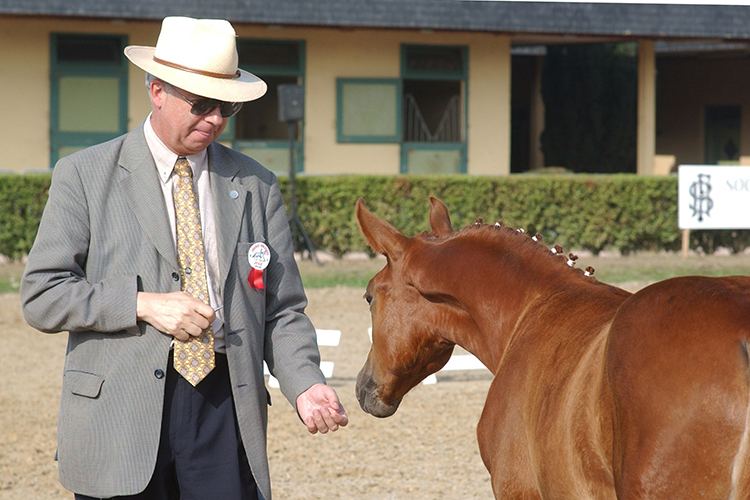
Some final thoughts from Bernard Maurel, the director of Pompadour – the National Stud for Anglo-Arab breeding – from 1995 to 2000. Pompadour was the historic centre of the Anglo-Arab breed, and its origin goes back almost a thousand years. The first château was built in 1026. Louis XV acquired the estate in 1745, and presented the entire property to his mistress, Madame Lenormand d’Etoiles, and with it the title: Marquise de Pompadour. Although she never lived there, the Marquise had a stud of Arabs and Barbs installed, although this breeding operation was not a success.
She fell out of favor with the King, and sold her property in 1760. This did not please Louis, and he re-acquired Pompadour and turned the estate into a Royal Stud Farm. The fortunes of the stud fluctuated, but it was up and running again in 1872, with populations of Thoroughbred, Arab and Anglo-Arab stallions.
It was also the only one of France’s national stud farms to have as well as a stallion centre, a breeding centre with some 40 Arabs and Anglo-Arab broodmares.
The Anglo-Arab originated at Pompadour thanks to Mr de Bonneval, one of the first main directors, and to Mr Gayot who organised his stud book. Sadly like all the other national studs, Pompadour was forced to close the stallion centre in 2015. But the brood mare band still exists, although reduced at 25 mares, dedicated to sport production. It is still therefore a centre for Anglo-Arab production and breeding shows, aside to many races, competitions, and auctions organised there. The National Stud of Pompadour is now part of the new Institut français du cheval et de l’équitation, state company resulted of the merging of the Haras Nationaux and the Cadre Noir de Saumur.
Bernard is more involved as an international dressage judge these days and teaching at the Saumur National Riding school, but the passion for the Anglo-Arab still burns bright:
“Your analysis is perfectly right… but you know that the selection of a breed takes minimum of two generations, and that in sport the interval between two generations is around 9 to 10 years. In the year 2000, the ANAA was still motivated more to get subsidies from the government system, than to promote the breeding and to help the breeders to find the best economical way to produce and market their horses. Of course they made many changes, and they are still active with breed shows and supporting activities, although on the base of a restricted number of passionate breeders.”

The broodmares at Pompadour
“Instead of having a selection goal for eventing and for obstacle races – and for a specific type of horses, intelligent, cooperative and athletic – they were following the market for showjumpers, and opened the Anglo-Arab stud book to foreign breeds. Therefore they start to lose they specificity, and they were not trying to support and focus on the pure bred Anglo. I don’t refer to the direct crossing using outside stallions, but about preserving the old families, and the stud book category with no other breed in the four first generations than Anglo-Arab, Thoroughbred, and Arab. We can understand that to sell the progeny, maybe it could be useful to have crossbreds (with SF, Holsteiner, or others) but at first you must keep the pure breed and all the efforts (and subsidies if possible of course) should be concentrated on that priority.”
“Of course this evolution was not the best strategy to enhance the old breeding lines. We saw the same in Selle Français, but they were clever a few years ago to start the SF Originel in order to avoid losing their specific image by melting it in the crossing with all the up-to-date stallions of other European stud books. You still have a few fantastic Anglo-Arab mare lines that remain, but if they are crossed too much with foreign stallions they are close to losing the main male or female producers.”
“If you look at the stallion’s Guide de l’Eperon (I participate in the dressage choice) for eventing you just find two AA (Quercus du Maury and Fango in Blue, that I promoted myself) and two AACR including the famous Upsilon and his half brother Tenareze who has three generations of AA, PS or AR on 14 selected stallions. In jumping you have Nathan de la Tour, King Size, the old Fusain du Defey, Orient du Py all with top class pedigrees but not so much following the fashion of European crossbreds…!”
“Maybe it’s the pressure of the market and of the economic crisis of 2007-2008 (with the clear reduction of the European sport horses production) that has made the breeders look for an immediate return from their breeding efforts, and forget the selection goal of keeping the breed as a specific one?”
Is it too late – can the breed be saved?
“Is it too late? NO, because there’s still many passionate and competent breeders of Anglo-Arabs. Can the breed be saved? YES, through their international network, with more focus on specific image and ability.”
You would hope so. It would be bitter irony, that just at the time the value of the Anglo-Arab as a component in the modern eventer is becoming apparent, this noble breed should disappear.


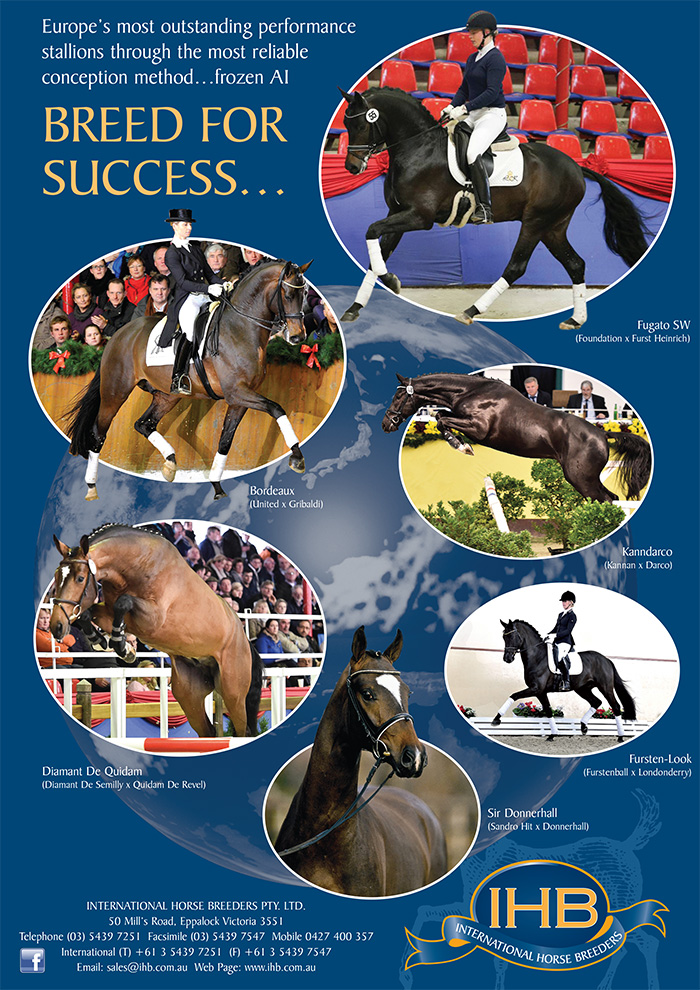
I have a young Filly by Upsilon ,she is out of a mare Urusla de Felicity ,by Credo DE Paulstra ,In 2017 she was a Finalist in the Champion de France at St Lo ,my plan is to compete her but have a foal from her at 4 years old ,I do not know what stallion to use yet maybe a Hanoverian or perhaps ,after reading the above article an ,AA stallion ,She is a very forward girl ,follows me everywhere , and she jumps well already . ,in her training ,but not too much ,i like to look after her legs ,but they seem to start earlier with the performance now ,so i am careful with her thanks we are small breeders in Normandie close to St LO ,cliff longlands